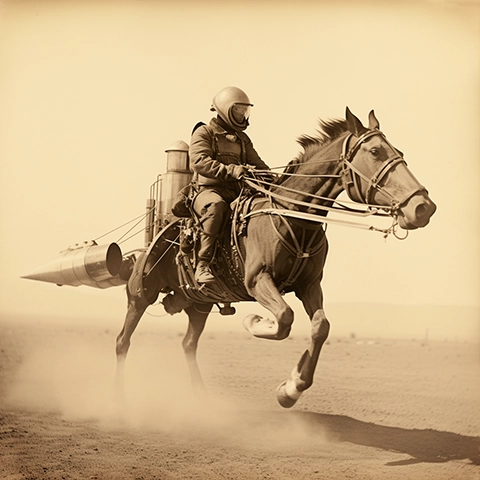In the early 20th century, as the industrial era surged ahead with the invention of the automobile, the once-dominant horse industry faced an unprecedented challenge. The allure of the automobile — with its speed, efficiency, and promise of modernity — began to eclipse the age-old reliance on horses. But the horse industry, resilient and resourceful, did not accept its looming obsolescence without a fight.
Adapting to Change
As cars began to dominate urban and suburban landscapes, those invested in the horse industry — from breeders and trainers to carriage makers and stable owners — searched for innovative solutions to keep horses relevant. They experimented with a myriad of techniques, from selective breeding programs that aimed to increase the stamina and speed of horses to training methods inspired by emerging scientific principles.
However, one of the most audacious experiments during this period was the integration of steam-powered propulsion systems to enhance a horse’s natural speed and endurance.
The Birth of the Steam-Powered Horse
Drawing inspiration from the steam engines that had revolutionized the railroad industry, inventors sought to harness that same power for equestrian purposes. Pictured in the provided image, we can observe one such experimental design where a horse is fitted with a compact steam engine and propulsion system. These contraptions, made of lightweight materials and designed to be aerodynamic, were intended to increase the horse’s speed while minimizing the burden on the animal.
The design allowed the horse’s natural gallop to activate the steam engine, which in turn provided an extra thrust, propelling the horse forward at speeds previously deemed unattainable for the creature.
Challenges and Criticism
However, integrating machinery with living beings was not without its problems. The contraptions were often cumbersome, and the horses required extensive training to adapt to these foreign additions. There were concerns about the safety of both the horse and the rider, with several reports of accidents due to mechanical failures.
Animal welfare activists raised voices against such experiments, arguing that they were inhumane and put undue stress on the animals. Moreover, the complexity and cost of producing and maintaining these steam-powered systems often outweighed the benefits they provided.
The End of an Era
Despite these innovative attempts to rejuvenate the horse industry, the practicality, efficiency, and scalability of the automobile eventually won out. The steam-powered horse, while a fascinating chapter in the annals of history, became a symbol of mankind’s occasional tendency to resist inevitable change.
However, the legacy of this period is a testament to human ingenuity and the enduring bond between humans and horses. While horses no longer dominate our roads and cities, they remain an integral part of our culture, history, and sports.
In the end, the horse industry did evolve, but not in the way many had hoped at the dawn of the automobile age. The era of the steam-powered horse serves as a poignant reminder of the intersection of tradition and innovation, and the relentless march of progress.

